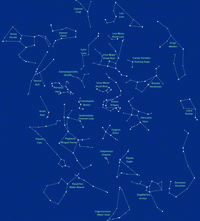Login form
Stars and constellations

One of the pleasures of camping is looking up at night into the heavens. Away from the lights of the city, you can see thousands of stars. At first, the night sky may seem to be a random scattering of brilliant points of light. Look more carefully, though, and you will notice that some stars are brighter than others. Night after night they appear in the sky at almost the same place. There is an order to their location. Learn about that order, and you will have a powerful skill for finding directions at night.
For thousands of years, people have grouped stars into pictured called constellations. The word comes from con meaning "together", and stella, meaning "star". This name started to times when Greek and Roman shepherds spent their nights under the open sky.
They imagined that different groups of stars formed the shapes of their kings and queen , warriors, maidens, animals, and monsters. The names they gave the constellations are still with us today. You will find those same constellations in the sky over your camps. Read about them, and you can discover much about the history and legends of ancient people who like you gazed with wonder at the stars above.
Stars to the North
Ursa Major is ancient name for a constellation called the Big Bear. Today it is also called the Big Dipper. You may have notice it before - four bright stars in the shape of a bowl and three stars making up a handle. Look closely and you may see that the middle star of the handle is really two stars. The Greeks called them Mizar and Alcor. Native Americans thought of larger star as a horse, the smaller as a rider.
To find the North Star, train your eyes on the "pointer stars" of the Big Dipper - the two stars farthest from the handle. Extend an imaginary line through them. The North Star is on that line at a distance of about five times the distance between the two pointers. True north on the Earth lies at the horizon directly under the North Star.
Like the sun, most stars seem to move from the east to west across the sky. That is because the Earth is revolving beneath them. Since it is directly over the Earth's North Pole, the North Star doesn't appear to move at all
The North Star is also the last star in the handle of the Little Dipper, or Ursa Minor, the Little Black Bear. The Little Dipper appears to be pouring into the Big Dipper. Between the two dippers dangles a long line of faint stars - the tail of Draco the Dragon.
Remember the pointer stars of the Big Dipper? Follow that line beyond the North Star and you will come to five bright stars forming the shape of the letter W. That's the constellation Cassiopeia, also known as the Queen's Chair.
Due to the Earth's yearly rotation arround the sun, the location of ach constellation is different in the summer from its location in the winter. If you can, select a viewing spot far from streetlights and the glow of the city, Choose a night when there is little or no moonlight to obscure the brilliance of the stars
Just as you travel the backcountry by going from one landmark to the next, you can travel about the night sky by using the constellations you recognize as reference points leading you to star groups that are new to you.
by Raphael

